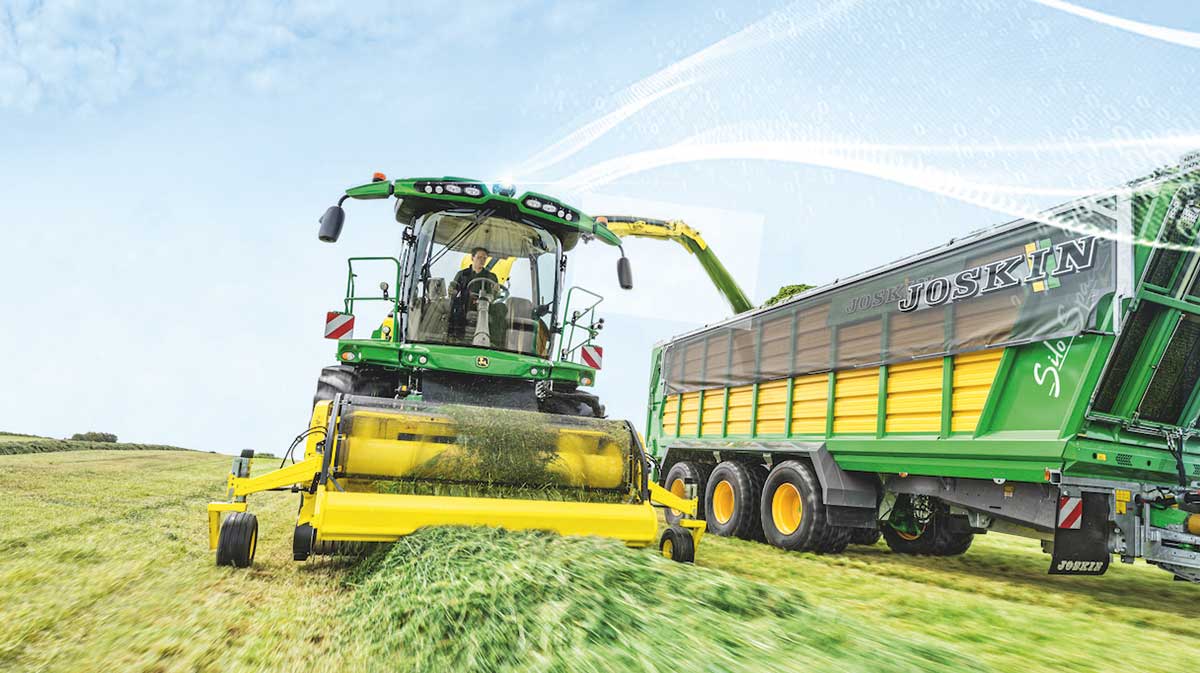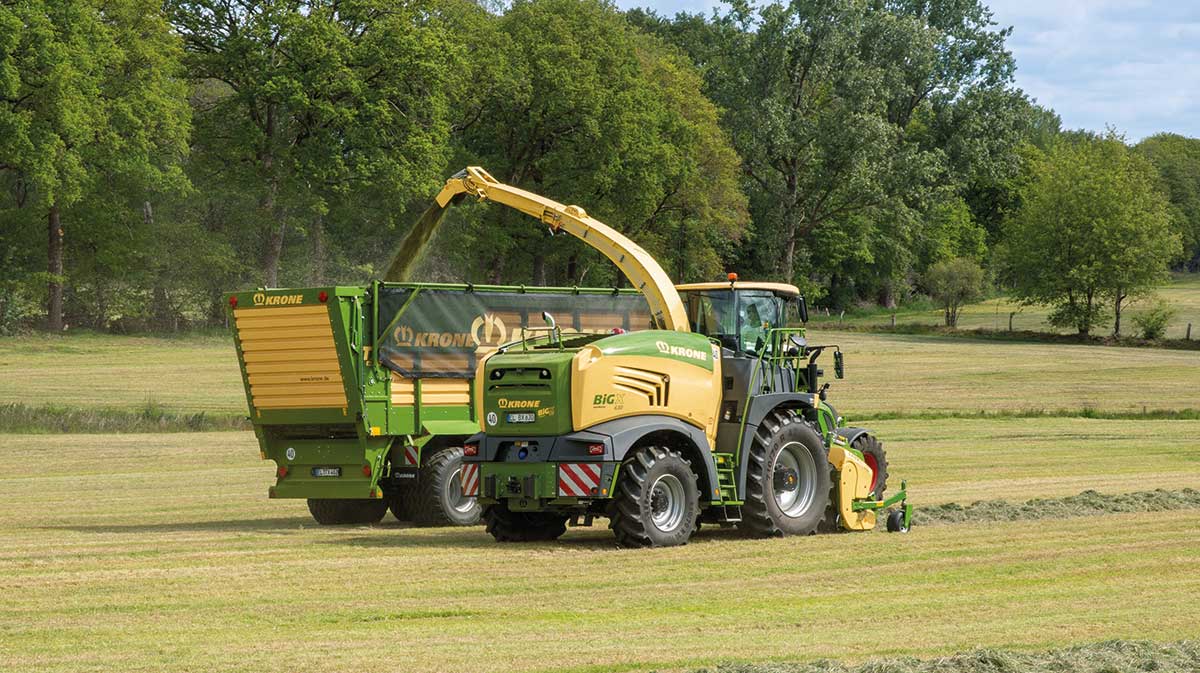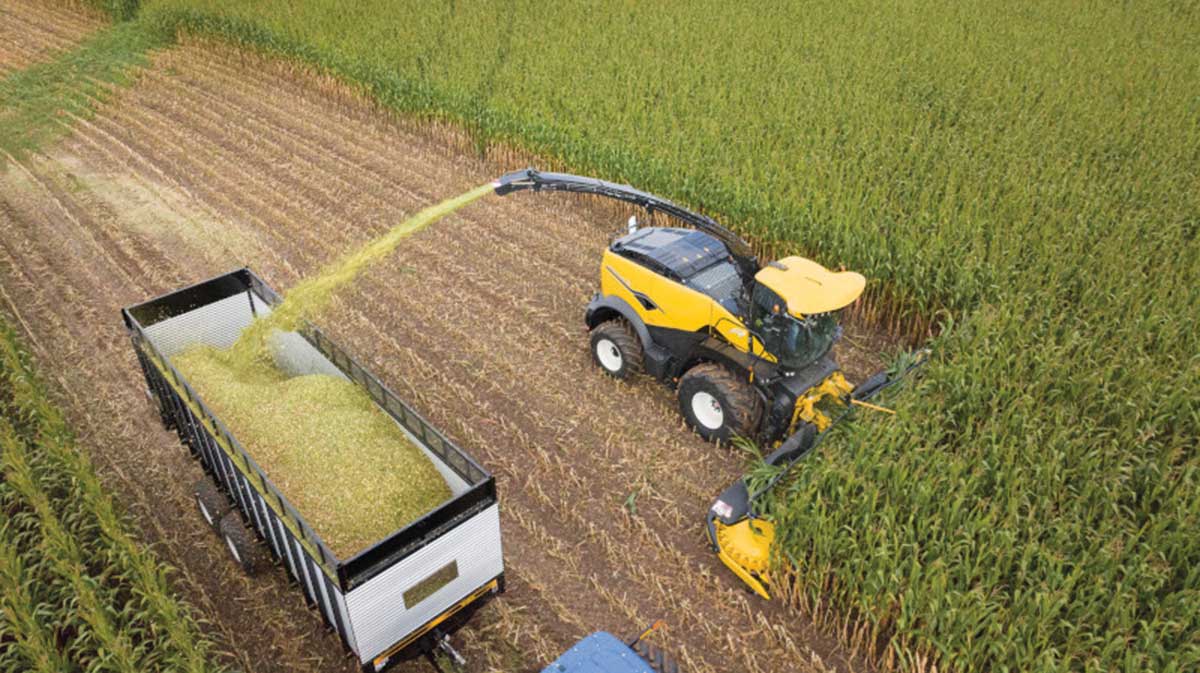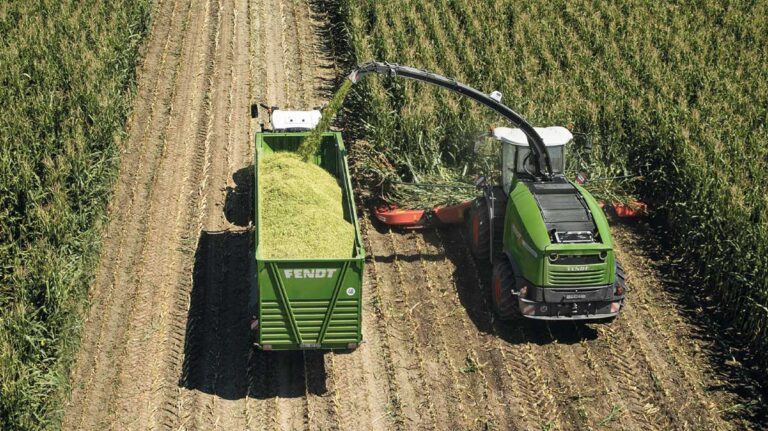The forage harvester remains one of the most powerful machines on the farm, often reaching the 900-1,000hp range. As they enter the most power-intensive forage crop of the year, maize, we take a look at the updates integrated by the key manufacturers.
Fendt
Fendt extended its self-propelled forager range in 2022 with the Katana 850, providing a model in the +800hp range for the largest-scale farmers and contractors. It is powered by a Liebherr D976 engine, said to be the largest in-line unit in this class.
To maximise efficiency, the software in the engine has been adapted, moving away from the Eco and Power modes previously available to incremental steps that enable the operator to find the right balance between engine speed and fuel use.
Output tweaks
Drivers can change output by adjusting the engine speed from 1,600rpm up to 1,900rpm in 50rpm steps, as well as choosing between four torque curves, optimised to the engine speed. When switching between curves, the forager will increase the engine rapidly for the higher curve, but slow gradually when moving down so as not to affect throughput.
A series of new Kemper headers were introduced to match the more powerful 850 machine.
While the 650 could be specified with models from the 360plus to the 490plus, offering working widths up to 9m, at Agritechnica Fendt announced the range would be compatible with Kemper’s new generation of pro headers, with the option of a third probe runner for the 375pro and 475pro, and a third skid as standard for the 390pro and 490pro. The headers, along with automatic row guidance, can be specified for both the 650 and 850.
Fendt also offers a near-infrared (NIR)system, developed by IT Photonics, to measure crop constituents. In addition to this, the Katana will automatically adjust the fresh matter yield map based on readings from the NIR sensor.
This reduces the number of times that the yield measurement system needs calibrating and increases the accuracy of the data collected.

John Deere
John Deere offers a range of forage harvesters in the 8000 and 9000 ranges. The 8000-series comes with a styling update that aligns with the 9000-series, updated feedroll design and an upgraded John Deere premium kernel processor.
The 8100 model’s PowerTech 9-litre engine now has more output, producing 425hp at its peak, while the new 8200 model features a more powerful 13.5-litre engine, maxing out at 465hp. The 8300 model has also received a healthy horsepower upgrade to 505hp.
Moving on to the 9000-series, John Deere has designed the new 18L JD18X engine – its most powerful engine yet, starting at 754hp maximum output on the 9500. The JD18X is equipped with JD engine controls, a high-pressure common-rail fuel system, turbochargers and its rear gear train significantly reduces noise, as well as torsional and crank stress.
The 9000-series is available with HarvestMotion and HarvestMotion Plus. HarvestMotion is said to deliver significantly higher productivity and more efficiency at reduced engine speeds. HarvestMotion Plus adds to this with torque rise and more power at low engine speeds to boost performance and efficiency.
High horsepower
The ProStream crop flow is designed with extra heavy-duty components for even higher engine horsepower outputs, and a throughput capacity of more than 400t/hour. The smooth arc of the channel minimises resistance for an even crop flow stream and lower wear.
HarvestLab 3000 enables automated length of cut adjustment depending on dry matter content, ensuring optimum silage compaction and conservation. Livestock and dairy farmers can profit from real-time detection of changes in feed quality and better silage additive control.
John Deere’s universal cutterhead is designed to perform with flexibility for different harvesting requirements. It will meet the operator’s demands without having to compromise forage quality. Depending on specific requirements, operators can choose from either 40-, 48-, 56-, or even 64-knife configurations.

Krone
Krone offers a comprehensive range of self-propelled forage harvesters, splitting its BiG X-series in half. The 480, 530, 580 and 630 run from 490hp up to 653hp, while the larger 680, 780, 980 and 1180 machines start at 687hp and max out at 1,156hp.
The company offers a near-infrared dual system, which is capable of measuring nutrient levels in grass, maize and wholecrop in real time. More unique to the company is the XtraPower software update, which enables users to hire extra engine power.
According to Krone, this is especially helpful for contractors or farmers who work primarily in grass but have a small area of maize to complete. Between 10 and 250 drum hours of XtraPower are available, with transport time not included. To ensure that this is only used when required, the additional power is delivered on demand and can be switched off.
Sharpening stone
New for this year is the latest sharpening stone, which sharpens the blades on the chopping drum and is said to increase maintenance intervals.
According to Krone, it can carry out 2,200 grinding cycles without manual readjustment. It also reportedly leads to more consistent wear across the chopping components, maintaining the correct chop length for longer.
The EasyLoad auto-filling system loads trailers automatically by controlling the spout for precision filling down to the rear end and along the sides of the trailer.
The feature is particularly useful when opening a field.
The technology behind it consists of a system of cameras that mount on the spout and software that detects the trailer contours and controls the spout accordingly. At the same time, the software also detects the current filling level, so the spout continues filling all the way up to the trailer’s capacity.

New Holland
The 2024 Forage Cruiser offering from New Holland starts with the FR480, with a Cursor 13 engine producing 476hp.
The same engine sits in the FR550 (544hp) before being superseded by the Cursor 16, which powers both the FR650 (653hp) and FR780 (775hp). Sitting at the top of the range is the FR920, which houses a FPT Industrial V20 engine, with an output of 911hp.
Fan options
New features include variable and reversible fan options for both the FR480 and FR550, enabling the pitch of the blades to be adjusted to regulate the cooling effect. This is done automatically based on the harvesting conditions.
In the crop flow, a new blower door and front roll cover are also available, especially suitable for operators working in high-moisture maize crops. In addition to these, a crop stream projection plate has been added to the crop processor.
The durability of the cracker rolls has been improved, with the new DuraCracker including a tungsten-carbide coating over the teeth.
According to the company, this will reduce the impact of chipping and abrasion and provide a self-sharpening effect as the teeth begin to wear, maintaining the processing performance for longer.
Updates have also been integrated into the precision farming technology, with improved computing time and uprated accelerometer within the telematics module, boosting the quality of data provided. The new IntelliField feature will enable multiple machines in the field to share data, including A/B lines, coverage maps and boundaries.
Within the MyPLM Connect software, yield and moisture data can now be corrected if it is deemed to not be accurate after calibration, and a dedicated insight tab has been created to collate all data collected by the forage harvester. This can be customised to show the relevant data required.


